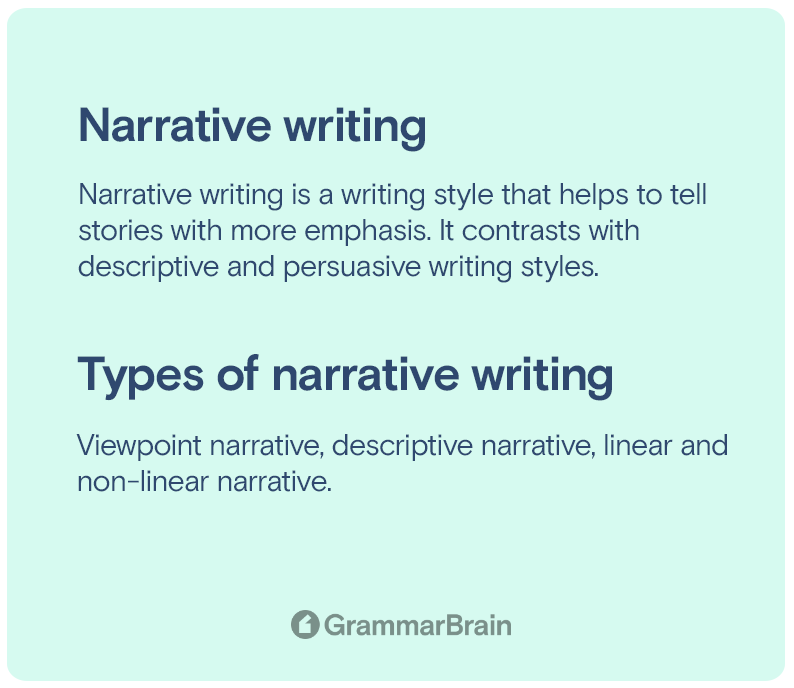

Narrative writing is a writing style that helps to tell stories with more emphasis. It contrasts with descriptive and persuasive writing styles. Learn everything you need to know about narrative writing in this comprehensive guide.
We have all read stories- both fictional and non-fictional. Narrative writing is exactly that- it is storytelling. While most narrative-style writing has a main character or protagonist, sometimes narratives can be about humanizing inanimate objects or abstract feelings.
Whatever happens to the said character or protagonist is called the story or the plot. Like most stories, narrative writing has conflict, resolution, and observation, and is in short- a story you would want to read.
Narrative writing is just one of the writing styles among others, namely expository, descriptive and persuasive writing. While all of the listed styles are very distinct, it is easy to confuse them for another. Hence, it is important to know the difference between each.
A descriptive style of writing focuses on rich imagery and sensory description of smells, sights, and sounds. It is usually used in screenplays, essays, and poems. It serves the purpose of immersion- where the reader can actively imagine themselves being transported to the place or situation that the author describes.
Persuasive writing is much like a political or philosophical text where one side attempts to establish its stance. Being persuasive in your writing style is a needed skill for reviewers and political columnists. Especially since they give essential takes on situations and decisions where the reader is persuaded by the text to agree or disagree with a certain argument. This style of writing is also applied in speeches, slogans, editorials, and opinion pieces.
To know that we must first know what the expository style of writing is. Expository writing is more about facts than fiction. Think textbooks, neutral news articles, etc. Anything that states facts without sensationalizing them is an exposition. This is in direct contrast with narrative writing which is more about storytelling than about facts.
As the name suggests, a personal narrative is about a person. Usually, this person is you. A personal narrative helps see things from your personal perspective. Personal narratives are used where intimacy is required.
Because they offer a window into the writers’ beliefs, methods, and emotions, memoirs, autobiographies, and deeply personal story pieces captivate us as readers. However, publishing your whole life story is not necessary to produce a personal narrative.
A cover letter or an admissions essay may be written by a student, or you may be attempting to describe your relevant qualifications. Your story will center on personal development, thoughts, and experiences irrespective of your goal.
Because of its digestible style and the fact that humans are empathic beings, personal tales enable us to relate to the experiences of others.

Viewpoint narrative tells the story from the eyes of the protagonist. This lends a unique lens to the story as the reader journeys through the paragraphs to see it unfold in real-time as the protagonist goes through the events.
For instance, Moby Dick by Herman Melville utilized viewpoint narrative to make Ishmael’s motives in the story hit home for the reader.
This is usually written in the third person as the descriptive narrative style entails a descriptive account of a situation, person, or place. But, many descriptive style narratives are written in the first person too. Usually, it uses vivid imagery and sensory words that help the reader immerse in the story.
If the progression of the events in the plot happens one after the other, then it is a linear narrative style of writing. For example, in Adventures of Huckleberry Finn by Mark Twain, everything happens in a linear chronological order. Whereas in a book like The Da Vinci Code by Dan Brown, there are multiple competing timelines that occur simultaneously. Such a style of narrative writing is non-linear.
1. Descriptive communication: Instead of explaining facts straight, this form of language elicits sentiments. Imagery, personification, similes, and metaphors are examples of descriptive linguistic devices.
2. Characters: A narrative may have a small cast of characters or a large one. The narrator is sometimes the lone character to appear in certain narratives. The tale is being recounted from the perspective of the narrator, who may or may not engage with the other characters.
3. Plot: The sequence of events that take place in your tale makes up the plot. A storyline might be straightforward with just one or two key events, or it can be intricate and have several layers.
4. Structure: Each narrative, even those that are nonlinear, is ordered in some fashion. This is how the central protagonist chases their objective or responds to a problem. No matter how you arrange your story, there are three main sections:
5. Theme: Each narrative has a theme whether you intend it to be or not. For instance, Harry Potter is about magic, Little Women is about female adolescence, and To Kill a Mockingbird is about racism and childhood trauma.
Narrative writers have most if not all of the following skills:
Narratives require a structure, even if it is non-linear and complex, with multiple parallel timelines. For example, To Kill a Mockingbird by Harper Lee is a chronological narrative where the older protagonist narrates a story that happened during her childhood.
The start captures the readers and encourages them to keep reading. Hence, it is important to craft interesting beginnings for stories.
For example, George Orwell’s iconic sci-fi novel 1984 opens with the sentence, ‘It was a bright cold day in April and the clocks were striking thirteen.’
It’s an incredible opening to set the mood for a book that is about surveillance and the dystopian future of commodifying privacy.
Description is like salt- it is necessary, but if overdone, can ruin the story. If what you are describing is not of the essence to the plot, it can get very boring for readers to go through paragraphs of descriptions of meadows(a la Tolkien).
For instance, A Clockwork Orange by Anthony Burgess does a wonderful job of letting the description and detail be an effective plot device. It isn’t overdone nor is it left fully to the readers. It is immersive enough for the reader to be engrossed but relevant enough for the reader to want to keep reading.
Suspense is a great technique to make the reader turn pages. It is a tried and true way to win a reader’s interest. There is simply no way to talk about suspense without mentioning Agatha Cristie. Her 1939 novel And Then There Were None displays the mastery of Cristie. She keeps the reader engaged till the very end to find out who is the killer on the island where a band of vacationers mysteriously die off.
Pacing is incredibly important in storytelling. If you spend 3 chapters setting up a conflict that gets solved in one page, it is not as gratifying of an ending. Hence, it is important that the main event is identified and written about in a way that uses action, description, and ample establishment prior to its reveal.
The wagonette swung round into a side road, and we curved upward through deep lanes worn by centuries of wheels, high banks on either side, heavy with dripping moss and fleshy hart’s-tongue ferns. Bronzing bracken and mottled bramble gleamed in the light of the sinking sun. Still steadily rising, we passed over a narrow granite bridge and skirted a noisy stream that gushed swiftly down, foaming and roaring amid the gray boulders. Both road and stream wound up through a valley dense with scrub oak and fir.
At every turn Baskerville gave an exclamation of delight, looking eagerly about him and asking countless questions. To his eyes, all seemed beautiful, but to me, a tinge of melancholy lay upon the countryside, which bore so clearly the mark of the waning year. Yellow leaves carpeted the lanes and fluttered down upon us as we passed. The rattle of our wheels died away as we drove through drifts of rotting vegetation. Sad gifts, as it seemed to me, for Nature to throw before the carriage of the returning heir of the Baskervilles.
The majority of the chapter’s first half was made up of rather fast-paced conversation. But the action slows down when the protagonists approach the moor. Doyle uses a couple of techniques to maintain this slower tempo. The wording grows increasingly detailed as the phrases lengthen and become more complicated. This is a great example of good pacing while describing the main events.
Good endings don’t mean that the end needs to be a happy one. It just means that it has to make sense and leave the reader with a feeling of something intense. It can be happiness, sadness, anger, or even hopefulness. What the reader shouldn’t feel are boredom and predictability. In many cases of good stories, even if the ending is predictable, it is done in a way that makes sense and leaves the reader wanting more.
Inside this article

Fact checked:
Content is rigorously reviewed by a team of qualified and experienced fact checkers. Fact checkers review articles for factual accuracy, relevance, and timeliness. Learn more.

About the author
Dalia Y.: Dalia is an English Major and linguistics expert with an additional degree in Psychology. Dalia has featured articles on Forbes, Inc, Fast Company, Grammarly, and many more. She covers English, ESL, and all things grammar on GrammarBrain.